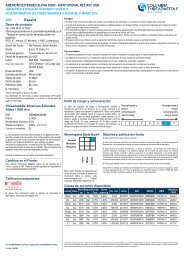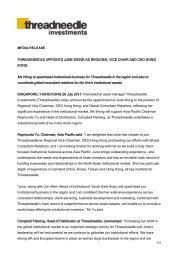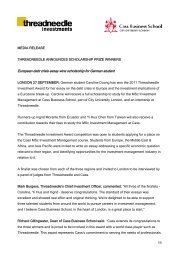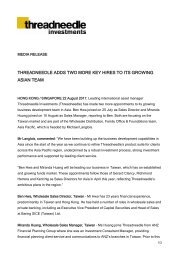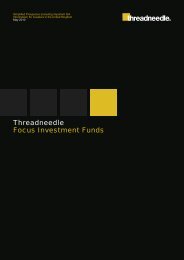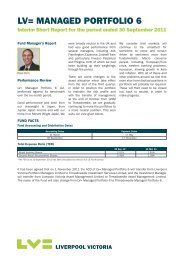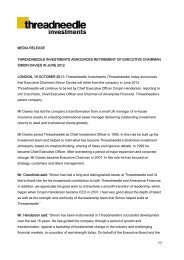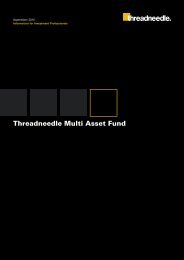Threadneedle UK Property Fund II - Threadneedle Investments
Threadneedle UK Property Fund II - Threadneedle Investments
Threadneedle UK Property Fund II - Threadneedle Investments
Create successful ePaper yourself
Turn your PDF publications into a flip-book with our unique Google optimized e-Paper software.
<strong>Threadneedle</strong> <strong>UK</strong> <strong>Property</strong> <strong>Fund</strong> <strong>II</strong> Interim Report and Accounts 2012<br />
Manager’s Report<br />
(continued)<br />
As displayed in the table above, it was the office sector that<br />
generated the strongest total returns over the period,<br />
registering 6.4% and being the only sector with positive rental<br />
value movement. This was however very much a product of the<br />
relatively strong performance of the Central London submarket<br />
which produced total returns of 10.4%. The retail and industrial<br />
sectors both suffered negative rental value growth of –1.1%<br />
and –0.8% respectively, although the industrial sector’s higher<br />
income return resulted in it generating a total return of 5.9%<br />
compared to that of the retail sector of 3.0%.<br />
Market Outlook<br />
With GDP growth of 0.3% forecast, output levels in 2012 are<br />
predicted to be low. Such low growth and output will<br />
undoubtedly hold back expansion in the occupier markets,<br />
which, coupled with a lack of available debt, will also act to<br />
limit activity levels in the investment markets. The issue of<br />
forced disposals through legacy debt issues will also be<br />
prominent, as the <strong>UK</strong> banks look to further deleverage balance<br />
sheet exposure. Banks still have more than £210bn exposure to<br />
<strong>UK</strong> commercial property, with nearly a quarter of loans in<br />
breach of terms or default. More than half the debt has to be<br />
repaid by 2016 with approximately £50bn due to mature this<br />
year.<br />
With only modest inflows into <strong>UK</strong> pooled property funds and a<br />
dearth of debt finance to take its place, it has been no surprise<br />
that recent months have seen small incremental falls in<br />
property capital values across the market. Perceived volatility<br />
in the financial and economic environment, particularly centred<br />
around the Euro crisis, has not helped risk aversion amongst<br />
investors. We expect these dynamics to be an on-going feature<br />
of 2012, with investors in property benefiting from the sector’s<br />
solid income return but seeing this eaten into by modest<br />
negative capital value movements. Beyond this immediate<br />
outlook we remain of the view that prevailing property pricing<br />
does look logical and supportable over the longer term<br />
perspective, a time horizon that property investment, by its<br />
nature, demands.<br />
An eventual return to trend economic growth in the <strong>UK</strong> does<br />
present real upside for <strong>UK</strong> property markets, the majority of<br />
which have experienced a de minimus level of fresh<br />
construction activity for nearly half a decade. The Company is<br />
now experiencing a period of stability following a pronounced<br />
expansionary phase.<br />
Although <strong>UK</strong> property fund inflows are currently at negligible<br />
levels, it is reported that, after record inflows in the period<br />
3Q09-4Q10, institutional investors still hold significant<br />
un-invested cash balances, but remain wedded to a cautious<br />
investment approach. Institutional investors seeking to exploit<br />
the property sector’s income yield advantage, relative to<br />
competing investment media, remain focussed upon the<br />
acquisition of core/core+ property assets, long-let to<br />
undoubted tenant covenants. Institutional investors currently<br />
have little appetite for entrepreneurial property risk.<br />
The Portfolio<br />
The average weighted lease length across the entire portfolio<br />
of 12 properties and 14 tenancies is approximately 5 years,<br />
assuming all lease break options within the existing portfolio<br />
are exercised. The Company’s directly held property generates<br />
a combined net initial income yield of 6.4% a 10 basis point<br />
income yield advantage above the comparable (IPD Monthly<br />
Index) market yield.<br />
We have shown a sector breakdown of the portfolio below, which<br />
shows the Company’s position versus the IPD <strong>UK</strong> Monthly Index.<br />
Sector breakdown – as at 30th June 2012<br />
Company Index Active<br />
Retail Warehouses 18% 24% –6%<br />
Shops 47% 23% 24%<br />
Industrials 21% 17% 4%<br />
Offices 14% 31% –17%<br />
Other – 5% –5%<br />
<strong>Property</strong> Type Overview<br />
47%<br />
Source: <strong>Threadneedle</strong><br />
We have shown a sector breakdown of the portfolio below,<br />
illustrating the Company’s position versus the IPD <strong>UK</strong> Monthly<br />
Index.<br />
Sector Breakdown as at 30th June 2012<br />
50%<br />
45%<br />
40%<br />
35%<br />
30%<br />
25%<br />
20%<br />
15%<br />
10%<br />
5%<br />
0%<br />
Company<br />
Index<br />
Offices Shops Industrials Retail Other<br />
Warehouses<br />
Source: <strong>Threadneedle</strong>/IPD<br />
14%<br />
18%<br />
21%<br />
Offices<br />
Industrials<br />
Retail Warehouses<br />
Shops<br />
Other<br />
Income returns will form the core component of total returns<br />
over the next 5 years and capital value gain will have to be<br />
4




